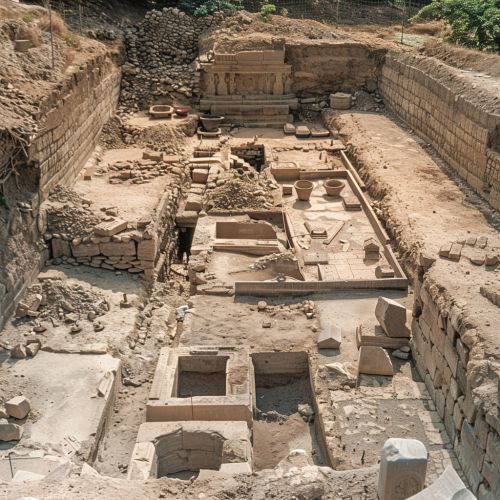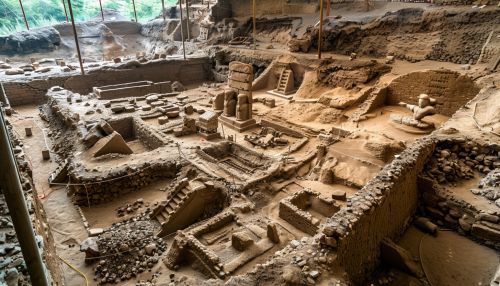Yin ruins
Introduction
The Yin Ruins, also known as the Yinxu, are the remnants of the last capital of China's Shang Dynasty (c. 1600–1046 BCE). Located near the modern city of Anyang in Henan Province, the site is one of the oldest and largest archaeological sites in China. It is renowned for its historical significance, particularly in the context of early Chinese civilization, and is a UNESCO World Heritage Site. The Yin Ruins provide invaluable insights into the political, social, and cultural aspects of the Shang Dynasty.
Historical Background
The Shang Dynasty is traditionally considered the second dynasty in Chinese history, succeeding the semi-mythical Xia Dynasty. The dynasty is known for its advances in metallurgy, writing, and urban planning. The Yin Ruins mark the final phase of the Shang Dynasty, often referred to as the "Late Shang Period." This era is characterized by significant developments in bronze casting, oracle bone script, and complex societal structures.
Discovery and Excavation
The Yin Ruins were first discovered in the late 19th century by local farmers who unearthed oracle bones, which were used for divination purposes. These bones, inscribed with the earliest known form of Chinese writing, attracted the attention of scholars and archaeologists. Systematic excavations began in the 1920s, led by the Institute of History and Philology of the Academia Sinica. Over the decades, numerous artifacts, including bronze vessels, jade objects, and pottery, have been uncovered, providing a comprehensive understanding of Shang culture.
Archaeological Findings
The Yin Ruins cover an area of approximately 30 square kilometers and consist of several key components, including palatial complexes, royal tombs, and residential areas. The site is divided into different zones, each serving distinct functions.
Palatial Complexes
The palatial complexes at Yin Ruins are among the most significant discoveries. These structures, built on raised platforms, were likely the administrative and ceremonial centers of the Shang Dynasty. The architecture reflects advanced construction techniques, including rammed earth walls and wooden frameworks.
Royal Tombs
The royal tombs at Yin Ruins are elaborate burial sites that provide insights into Shang burial practices and beliefs in the afterlife. The most famous tomb is that of Fu Hao, a consort of King Wu Ding. Her tomb contained a wealth of artifacts, including over 1,600 objects made of bronze, jade, and ivory, as well as human and animal sacrifices.


Oracle Bones
Oracle bones are one of the most significant finds at the Yin Ruins. These bones, typically ox scapulae or turtle plastrons, were used for divination by Shang kings. The inscriptions on these bones are the earliest known form of Chinese writing and provide valuable information about the political, social, and religious aspects of the Shang Dynasty.
Cultural Significance
The Yin Ruins are a testament to the cultural and technological achievements of the Shang Dynasty. The artifacts and inscriptions found at the site offer a glimpse into the daily life, religious practices, and governance of one of China's earliest civilizations.
Bronze Casting
Bronze casting was a highly developed craft during the Shang Dynasty, and the Yin Ruins have yielded numerous bronze artifacts, including ritual vessels, weapons, and tools. The intricate designs and inscriptions on these objects reflect the high level of skill and artistry achieved by Shang craftsmen.
Oracle Bone Script
The oracle bone script is the earliest form of Chinese writing and is a precursor to modern Chinese characters. The inscriptions on the oracle bones provide valuable information about the language, politics, and culture of the Shang Dynasty. They also offer insights into the development of Chinese writing and its role in administration and communication.
Religious Practices
The religious practices of the Shang Dynasty are well-documented through the artifacts and inscriptions found at the Yin Ruins. The Shang people practiced ancestor worship and believed in a pantheon of gods and spirits. Rituals, including sacrifices and divination, played a central role in their religious life.
Preservation and Conservation
The Yin Ruins have been the focus of extensive preservation and conservation efforts. The site is protected by the Chinese government and has been designated a National Key Cultural Relic Protection Unit. Ongoing archaeological research and conservation work aim to preserve the site for future generations and to continue uncovering its historical treasures.
